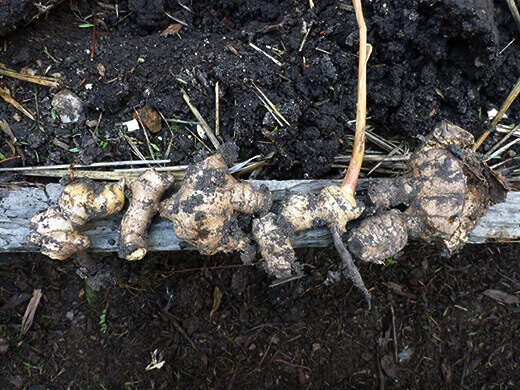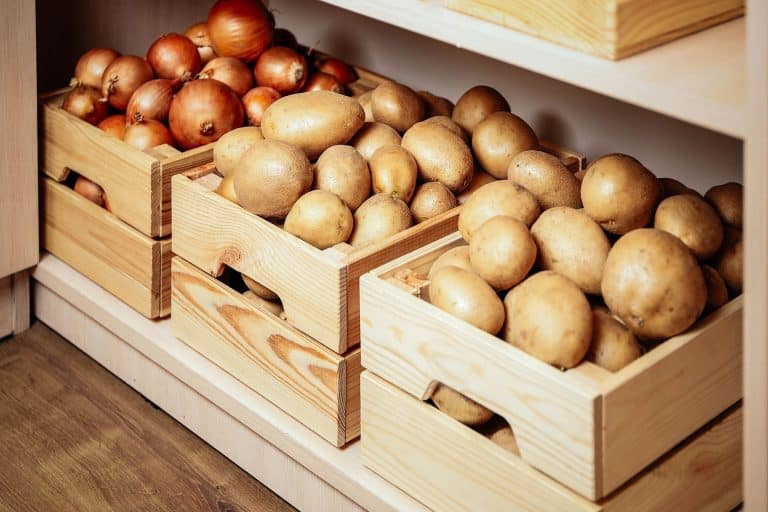More than a year after I rooted the rhizomes, I finally have my first ginger harvest!
I rooted the rhizomes back in October 2010 using store-bought ginger with healthy growing nubs. They overwintered in the ground and slowly started growing again this past spring, putting out new shoots and leaves and becoming lush, green plants just under 2 feet tall.
As temperatures cooled, the foliage died back naturally, indicating a good time to harvest. This happened right “on schedule,” as ginger is mature for harvest about eight months after planting. In climates with frost, ginger is normally planted in early spring so that it can be harvested in late fall when the foliage starts to die back. The mild winters in SoCal, however, allow for rhizomes to be left in the ground where they stay dormant until spring.

If I had let my plants overwinter again, the ginger would resume growing upon warmer weather and even start blooming. Most gardeners never see flowers on their ginger crop though, since they’re typically treated as annuals.
Once the leaves on my plant turned brown, I carefully dug around the withered stem until I found a knob of ginger poking out from the soil. If you’re very good, you can pull up the whole thing in one piece. I happen to not be very good, so I freed the ginger in random chunks.


Ginger can be harvested piece by piece by digging up and breaking off a small section of the rhizome, leaving the rest underground to continue growing. A harvest around six months gives you baby ginger, which has a milder flavor and light, tender skin (without the rough outer peel). Or, you can pull up the whole clump at maturity, cut off what you need, and replant the remaining chunk, making sure you leave a couple of good sprouting buds on it.
After realizing I don’t like digging up thickly rooted plants, I decided to harvest all my rhizomes this week, and root new ones later this winter in a large container. That way, I can simply tip the whole container over next winter and hope for handfuls of ginger to come tumbling out!

So there you have it. My first ginger harvest. They do clean up nicely!


















Is this true? Every website about growing ginger contradicts. Some say it goes dormant. Some say it doesn’t. Some say you harvest after 5 months and some say 10. Some say it depends on what type, but none seems to really explain what these different types are! I planted a store-bought ginger in July (in a container) and have mostly had it growing in the basement next to a window since since I got tired of dealing with bugs eating the shoots…anyway, it started looking like it was dying in December, and as of typing this it’s January and it’s not completely “dead” looking yet but idk. Is it dormant or dead? I dug around a little and it didn’t seem to be rotting (it actually smelled very gingery which I guess is a good sign) but the one “knob” seemed…idk…wet?…slightly greenish…?…not, like, super squishy or anything…idk…it’s the one that had the first completely dead shoot…well, it’s hard to care for ginger since there’s like no solid info out there.
All of the growing and harvesting information I know is presented here in this post, as well as the two posts linked in my introduction, and I believe they should answer most of your questions.
Store-bought ginger is common ginger (Zingiber officinale). July to December is not a sufficient growing season for ginger, especially if you’ve had it in a cold basement. Most likely, the cold temps caused the foliage to die back naturally, leaving the rhizomes dormant underground. The only time the entire plant is dead and un-harvestable is when the rhizome is rotted, and the only way to know for sure is by digging up all of your rhizomes and examining them. They should not be green.
I remember my husband complained of upset stomach. When I suggested for him to drink hot ginger tea, he just laughed at me. He had never tasted ginger tea before. He waited almost half a day, then he asked, “Are you sure ginger tea will cure me?” I got a piece of fresh ginger, scraped the outer part, sliced thin, and boiled in 2 cups of water. He was thankful as he got BETTER!!!
We use ginger tea when we have nausea. When served as tea, it helps to relax and calm any internal spasms. Other Oriental countries, ginger is use to overcome mushrooms poisoning. When nauseated, we drink warm ginger tea.
ASIAN countries
In the Philippines where I came from, Ginger is one of the top herbal medecines you will find in every kitchens. Fresh ginger or small amount of powdered ginger, helps stimulates the digestive organs. Ginger tea helps stimulates a delayed menstrual period. It also helps to relieve severe menstrual cramps.
How long does ginger keep once harvested?
Mine keeps for about 2-3 weeks in the fridge… sometimes longer, if I seal it in an airtight container after using it.
Can you freeze it?
Yes, you can freeze the whole root or just spoonfuls of grated ginger.
It’s so interesting to see how ginger grows. thanks for sharing.
Wow, lovely thank you for the share
Whoooooah… I never even THOUGHT about growing Ginger?!?! So cool. My first thought was “hmm, this seems easier to just buy” but then I realized that one of the things on my christmas list is mushroom spawn. … : /
Well, it’s easier to buy most things, but that takes the fun out of growing them. 🙂
Next year I’m going to harvest part of my ginger early because baby ginger is actually not as easy to find. I would love to grow my own mushrooms too!
Just came across your blog from the Country Living 50 Things to Do site. I am interested in starting a garden because my mother always had one when I was growing up. She grew ginger, but the baby ginger just dipped with miso was a treat. I’m glad to come across your blog. I, too, live in SoCal, it’s nice to know what can be grown in the same area.
Thanks for visiting my blog! I’m glad you’re finding something useful here. 🙂
Those remind me a lot of iris tubers. I wonder if they are related?
Ginger and iris both sprout from rhizomes and are monocots, but I don’t believe they’re in the same family.